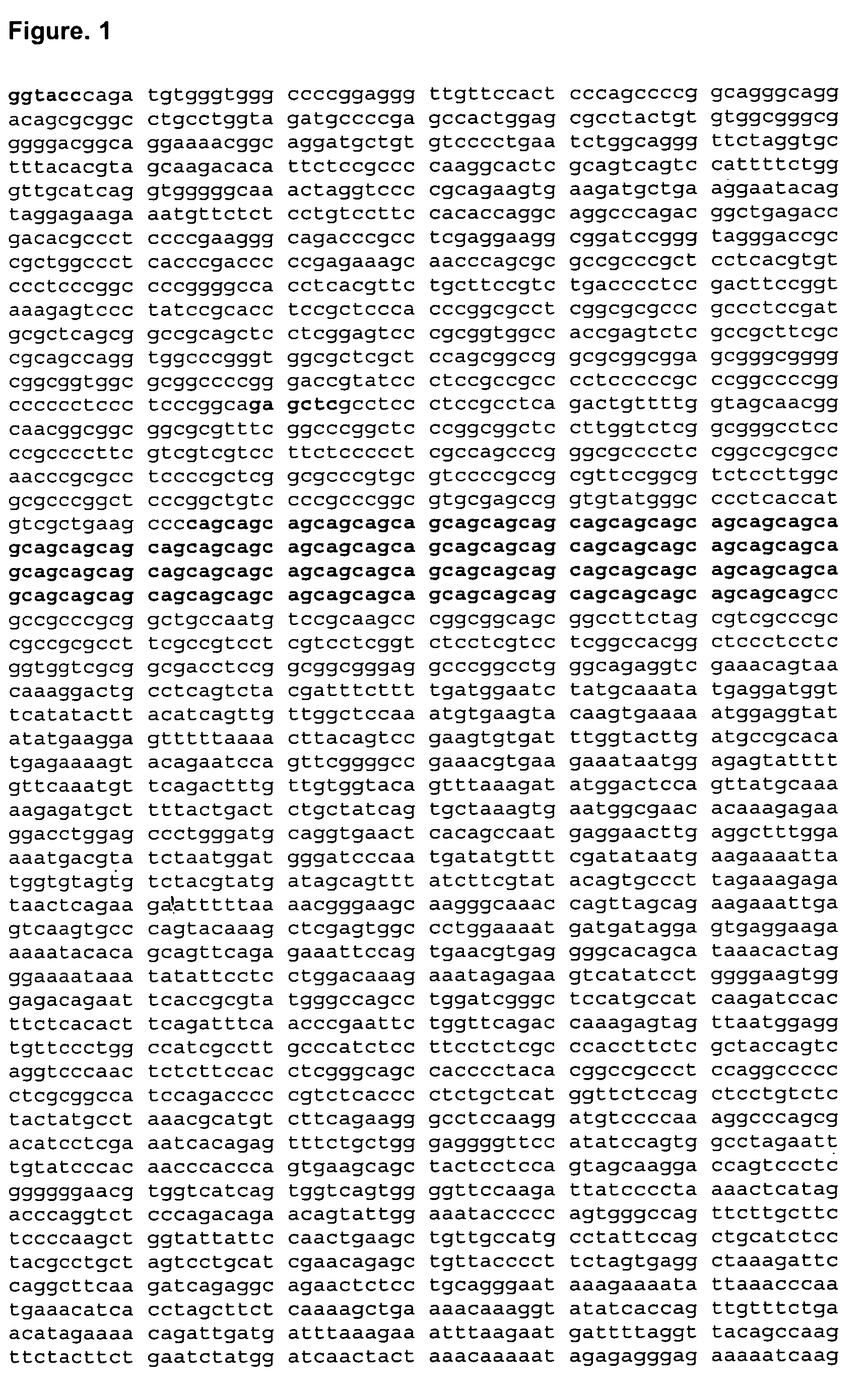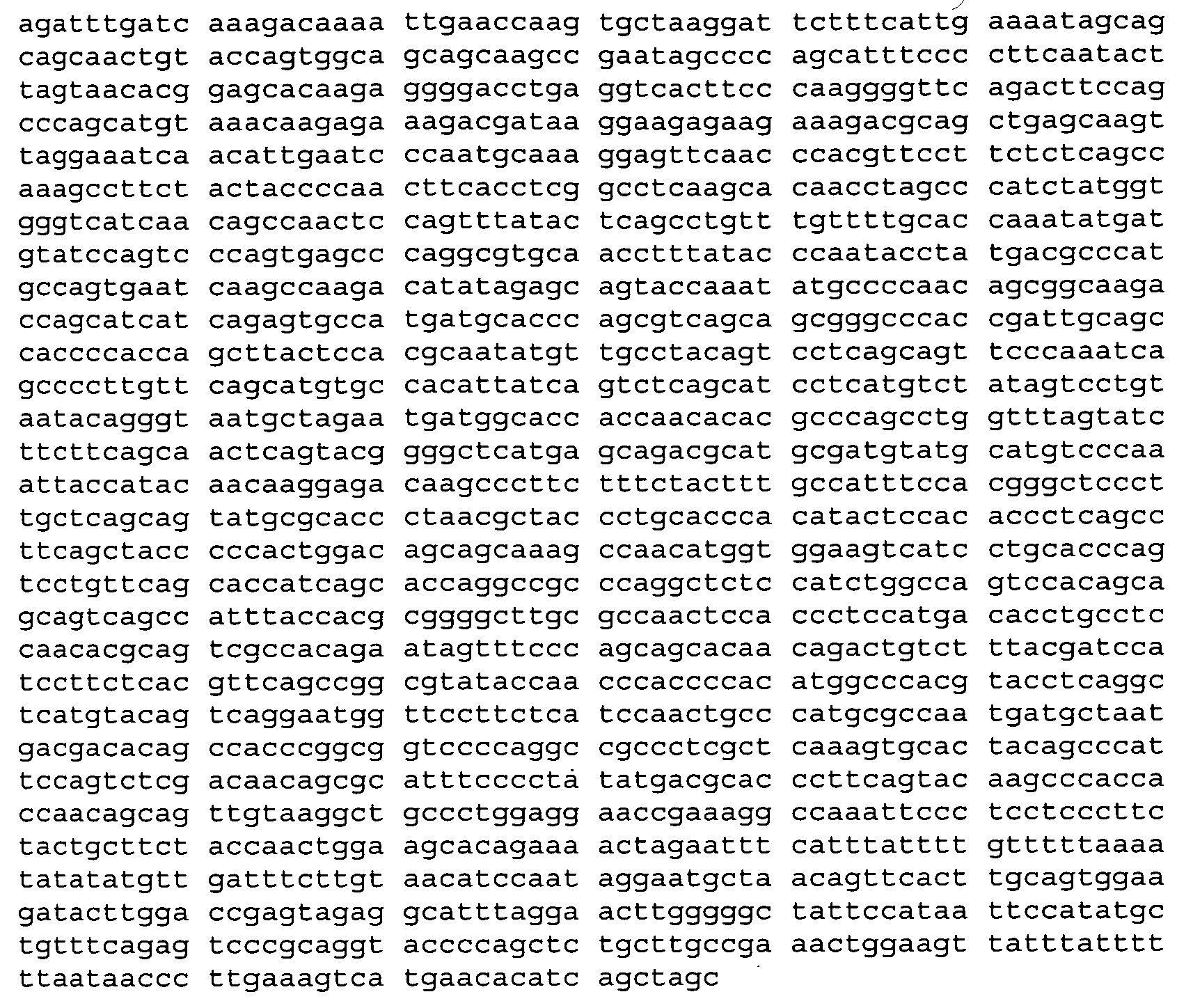F066 transgenic mice that express pathogenic mutants of the sca2 gene
a technology of sca2 and transgenic mice, which is applied in the field of neurobiology and transgenic animals, can solve the problems of difficult elucidation and aggressive degenerative process of huntington and sca diseases, limited observation to the terminal steady, and limited transgene expression and pathogenic protein production
- Summary
- Abstract
- Description
- Claims
- Application Information
AI Technical Summary
Problems solved by technology
Method used
Image
Examples
example 1
Obtention and Molecular Characterization of F0 Transgenic Mice Carrying sca2-75CAG Human Gene
[0045] The genetic construction is composed by the following elements 5′-3′ ordered (FIG. 2):
[0046] a) A 0.8 kbp fragment encoding human ataxin 2 gene promoter (Aguiar et al (1999) Cloning and sequence of the 5′ region from human spinocerebellar ataxia 2 gene. Biotecnologia Aplicada 16: 165-168, Aguiar et al (1999). Identification of the physiological promoter for spinocerebellar ataxia type 2 reveals a CpG island for promoter activity situated into the exon 1 of this gene and provides data about the origin of the nonmethylated state of these types of islands, Biochem. Biophys. Res. Commun. 254: 315-318).
[0047] b) A 4.217 kbp fragment encoding complementary DNA for sca2 gene carrying 75 CAG repeats. This fragment was obtained from a patient blood total RNA sample by RT-PCR.
[0048] c) A 0.268 kbp fragment encoding transcription termination and polyadenylation signals from SV40 virus, prese...
example 2
Functional Testing of Transgenic Mouse Line F066 by Rotarod
[0055] This example describes functional characterization of SCA2 transgenic mouse lines by Rotarod. Motor coordination performances of wild type, homozygous and heterozygous mice were tested using Basile Rotarod treadmills. The duration of the test was 5 days with 4 individual trials Mice were placed on an accelerating rod with a rotating speed from 4 to 40 r.p.m. for 300 seg and with a constant speed of 40 rpm until 600 seg with a resting time of 15 min, between each test. An example of mice performance on the test is represented in FIG. 8. The graph shows average performance on the Rotarod apparatus of four trials each day on five consecutive days. Transgenic mice fall early from Rotarod than wild type mice, showing motor deficit. Differences were significant for homozygous at 8 weeks, and for heterozygous mice at 16 weeks. Rotarod has been used extensively to assess functional impairment in SCA2 transgenic animals. Firs...
example 3
Evaluation of Homozygous Animals Derived From the F066 Mice
[0056] The homozygous mice derived from the FO66 mice, were obtained by matting the founder F066 mice and a transgenic F1 animal. The homozygous character was evaluated by matting with wild type animals. The progenies derived from the matting produced 100% heterozygous animals. The result was demonstrated by PCR analysis of F3 descendents. After analysis of DNA by PCR all the animals were positive for the presence of the ADNc-SCA2-75CAG transgene. The motor deficit was also demonstrated in all animals derived from a homozygous parent. The progenies derived from four generations keep the same morphological, reproductive and conduct phenotype as the parental animals.
PUM
| Property | Measurement | Unit |
|---|---|---|
| height | aaaaa | aaaaa |
| height | aaaaa | aaaaa |
| height | aaaaa | aaaaa |
Abstract
Description
Claims
Application Information
 Login to View More
Login to View More - R&D
- Intellectual Property
- Life Sciences
- Materials
- Tech Scout
- Unparalleled Data Quality
- Higher Quality Content
- 60% Fewer Hallucinations
Browse by: Latest US Patents, China's latest patents, Technical Efficacy Thesaurus, Application Domain, Technology Topic, Popular Technical Reports.
© 2025 PatSnap. All rights reserved.Legal|Privacy policy|Modern Slavery Act Transparency Statement|Sitemap|About US| Contact US: help@patsnap.com



